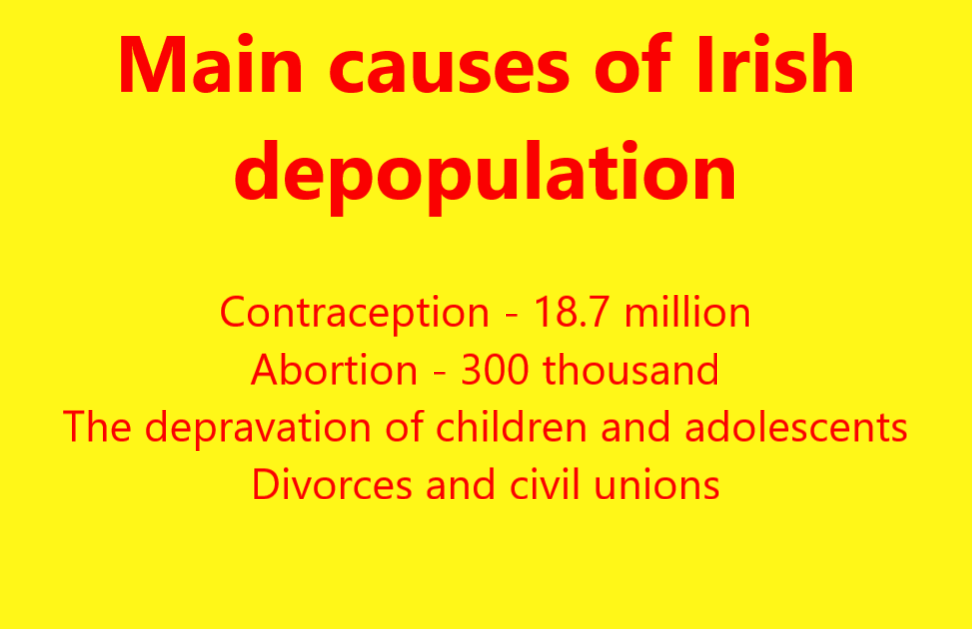Introduction
Over the centuries, Ireland retained its national identity, which was linked to the Roman Catholic Church. Even the rise of the Church of England did not break the Irish connection with Rome in the sixteenth century. Despite many persecutions, they maintained their faith and demographic dynamism until the mid-nineteenth century. The ideas of the civilization of death emerging on English soil reached the people of Ireland, reducing the number of children in their families. The process was unnoticeable and hard to spot, but it was wreaking havoc on the Irish. Already in the 1930s, a contraceptive mentality was born that weakened faith in God. Over time, another mentality emerged, an abortion mentality, which wreaked further spiritual, moral and biological havoc on the Irish. And faith became a cultural heritage, there was no godliness and piety. At the end of the twentieth century and the beginning of the twenty-first century, the Irish succumbed to the ideas of the civilization of death, legally accepted abortion, contraception, divorce and the depravity of children and adolescents. As a result, Irish families gave up several children in favor of one or two, and at most three, children. Marriage ceased to be the mainstay of society in favor of free unions. Ireland has become one of the fastest depopulating countries in the world.
Demographic changes of the people of Ireland compared to the global population
Between 1841 and 1900, the population of Ireland dropped two and a half times. Although the percentage of the Irish population in the world population was 0.66%, it decreased in the following years of the 19th century. In 1900, the world’s population increased to 1.61 billion1, and that of Ireland to 3.2 million2, which accounted for 0.19% of the world’s population. On the eve of World War I, the percentage of Ireland’s population in relation to the world population had decreased by 0.02%. Since 1925, the share of the population living within Ireland in the world population has been decreasing with each passing year. Within one hundred and eightyyears, the share of the population living within the boundaries of the Irish state in relation to the world population has decreased ninefold. So far, I have not noticed a major decline. Only native Germans, fivefold3, and the French4 had a slightly smaller decline in relation to the global population in Europe. Though the time frame was slightly shorter, only 120 years. During this time frame, the Irish decreased their share almost threefold.
Share of Irish residents in the world population in 1841-2020
| YEAR | World Population as of January 1st | Population of Ireland as of January 1st | Percentage of the World population |
| 1841 | 1 209 400 000 | 8 028 000 | 0,66 |
| 1851 | 1 270 014 000 | 5 111 557 | 0,40 |
| 1881 | 1 502 560 000 | 3 870 020 | 0,26 |
| 1900 | 1 646 165 000 | 3 231 000 | 0,19 |
| 1914 | 1 825 070 987 | 3 098 000 | 0,17 |
| 1925 | 1 967 683 298 | 2 985 000 | 0,15 |
| 1939 | 2 262 699 677 | 2 934 000 | 0,13 |
| 1950 | 2 513 866 197 | 2 969 000 | 0,12 |
| 1960 | 2 991 005 874 | 2 832 000 | 0,09 |
| 1970 | 4 023 981 107 | 2 950 000 | 0,07 |
| 1985 | 4 809 575 137 | 3 540 000 | 0,07 |
| 2000 | 6 088 230 944 | 3 790 000 | 0,06 |
| 2020 | 7 881 691 855 | 4 977 400 | 0,06 |
Over the course of 120 years, the Irish have diminished their population threefold in relation to the world population. So what happened to make Ireland’s population growth so small in the 20th and 21st centuries? Who contributed to slowing down the demographic boom?
(Graph of the share of Irish residents in the global population in the years 1841-2020)
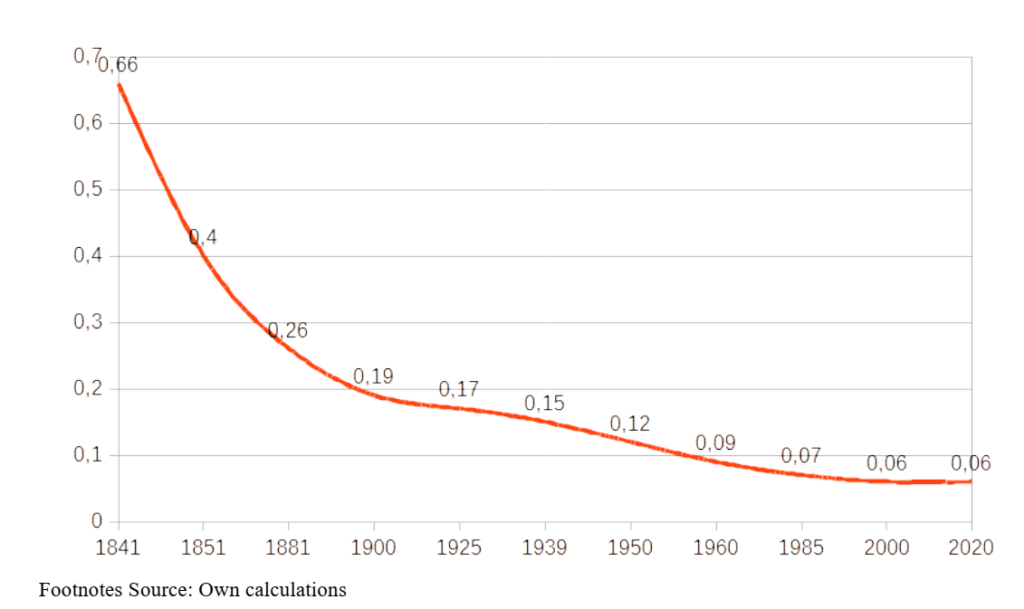
To better understand the decline in Ireland’s population relative to the global population, let’s analyze fertility rates over almost 170 years. When did the demographic collapse come about, what contributed to the reduction of the number of children in the families? Who contributed to this?
Fertility rates in Ireland in the years 1850-2020
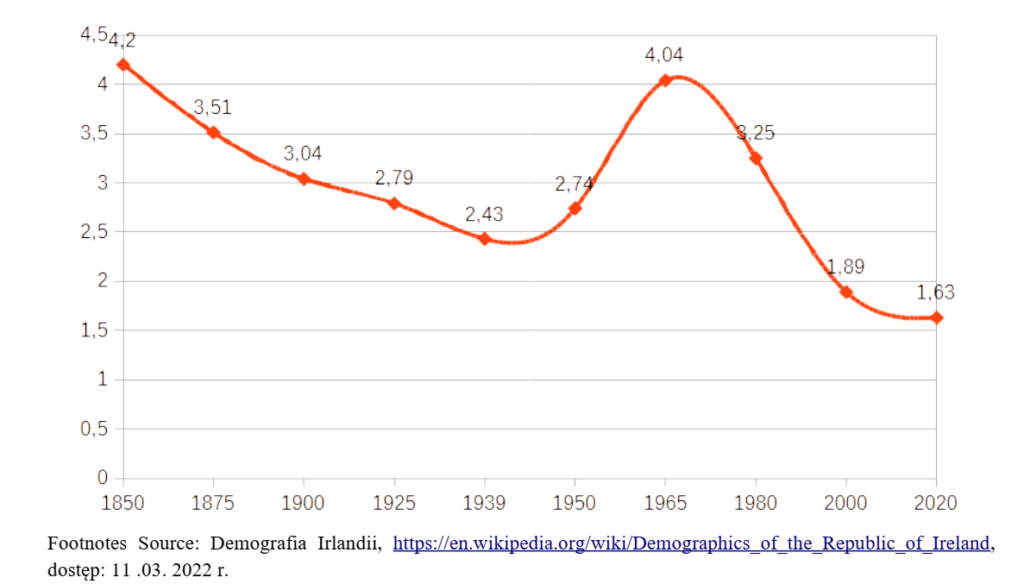
In the mid-19th century, there were over four children per woman of childbearing age in Ireland. In the second half of the nineteenth century, there was a sharp decline in the number of children in families. After fifty years, the number of children had decreased to three. Well it happened that in Ireland, the Catholic country began to shrink children in families. Well, until 1921 Ireland was a country within the borders of the Kingdom of England. The anti-natalist ideas that changed the cultural face of Great Britain also reached Ireland. There was a change of mentality among the people of Ireland. In the second decade of the 20th century, in 1922, propaganda of the idea of birth control began. Cultural ideas knew no bounds, they also penetrated into Ireland. Which resulted in the disappearance of large families over time, already in the 1930s. The period of World War II stopped the activities of the promoters of the civilization of death for several years. And this resulted in an increase in the number of children in families. For almost three decades, the Irish have experienced a demographic boom. In the mid-1960s, there were just over four children per woman of childbearing age. No country in Europe had such a fertility. It was a time when birth control pills were launched which were destroying fertility very quickly. High fertility rates in Ireland are recorded until the mid-1980s. In 1989, fertility rates were falling below the generation replacement rate. Since then, every year fewer and fewer children have been born into Irish families. In 2020, there were just over one and a half children per woman of childbearing age, which caused a galloping depopulation. Immigrants are the salvation for the Irish.
Contraception
The anti-natalist ideas propagated by the ideologues of the civilization of death from halfway through the mid-nineteenth century, the number of children in families decreased. Contraceptives decreased children in families, between 1850 and 1900 the fertility rates fell by almost one point, from four children per woman of childbearing age in 1880 to three in 1900. In the followingyears it was even worse. On the eve of the outbreak of World War II, there were just over two children per woman. Families ceased to have the character of large children. In 1935, the sale of contraceptives was banned, which outraged the socialist circles of various shades, extreme feminists and, above all, freemasons of various lodges. All the time, attempts were made to legalize contraceptives by resorting to various types of provocations5. Ultimately, contraceptives were introduced for sale in 1979, and the contraceptive pill wreaked the greatest havoc in the population, even though there were still restrictions due to marital status. Ten years after the contraceptive was launched, the fertility rates have dropped by more than one point. In 1979, there were more than three children per woman of childbearing age, and in 1989 there were only two6. Since 1992, contraception has become widely available7. Contraception has wreaked the greatest population havoc in Ireland and continues to be the main cause of depopulation and the demographic collapse that is leading the nation to non-existence.
All the time, attempts were made to legalize contraceptives by resorting to various types of provocations. Ultimately, contraceptives were introduced for sale in 1979, and the contraceptive pill wreaked the greatest havoc in the population, even though there were still restrictions due to marital status. Ten years after the contraceptive was launched, the fertility rates have dropped by more than one point. In 1979, there were more than three children per woman of childbearing age, and in 1989 there were only two. Since 1992, contraception has become widely available. Contraception has wreaked the greatest population havoc in Ireland and continues to be a major cause of depopulation and the demographic collapse that is leading the nation to non-existence.
Abortion
From 1861, killing an unborn child was punishable. The woman was respected in a blessed state. And the child under the mother’s heart was a blessing to home and family. Since the founding of the Republic of Ireland in 1921, abortion has been banned. In 1983, the protection of the unborn child was strengthened by the constitutional provision: „The state recognizes the right to life of the unborn, fully respecting the mother’s analogous right to life and guarantees that it is respected in the legislation and, if possible, the defense and assertion of this right in accordance with the applicable legislation”8. For years, left-wing circles fought to legalize abortion, committing various kinds of provocations, which were publicized by showing how wrong the Roman Catholic Church’s law against abortion is compared to the freedom to kill unborn children as the greatest achievement of „European civilization”9. Ultimately, the killing of unborn children was legally legalized in 2018. A referendum was held asking people in Ireland whether it was allowed or not to kill an unborn child. The Irish answered in a referendum that they did10. They became the gravediggers of their own nation. According to research by Robert Johnston, over 206,000 jobs were made in Ireland in the years 1968-2020. (homicides of unborn children). The data provided is of nature.
In 2020, over 206 thousand homicides of unborn children11. The data provided are estimates. To this number should be added about 100 thousand. earlier abortions that were performed before World War II and in 1945-1967.
In total, the population of Ireland decreased by about 300,000 as a result of the abortion. people. Socialists of various colors, revolutionary, communist, liberal, libertine, cultural anthropology, gender, masons of various lodges and extreme feminists are responsible for killing this mass of unborn children.
Divorces
For centuries, marriage in Ireland has enjoyed legal protection and stability. Nine years earlier, in 1986, the possibility of divorce was rejected as a result of a referendum. The Irish voted for the protection of marriage, the proposal to protect marriage was supported by over 63.5% of voters, while 36.5% were in favor of the possibility of dissolving the marriage. The marriage continued to enjoy legal protection and stability12. In 1995, another referendum was held, but the vote resulted in divorce13. 50.3% were in favor of divorce14. The marriage was no longer stable. Destructive circles, socialists of various colors, freemasons and extreme feminists triumphed. The destruction of the basic social unit was the greatest triumph of destructive environments.And scientific research shows that divorce contributes to the depopulation of entire nations. Thefall of ancient Rome probably began with the first divorce, in 231 BC15. The decadence began, which lasted until AD 476. Ireland’s decadence process is already underway and will fall much faster than ancient Rome.
In recent years, the number of marriages has been declining, while the number of divorces has increased. And so, in 2016, 22,626 marriages were concluded, and 3,197 marriages broke up (14.1%), in 2019, 19,673 marriages were concluded, and 4,020, i.e. 20.7%, broke up, and in 2020 – on the wedding carpet 9209 spouses16 became members and 5266 marriages broke up (57.2%)17. The destruction of the family and marriage in Ireland is very fast. Thus, Ireland’s decadent process is taking place at a rapid pace, which is translating into a huge depopulation of post-Catholic society.
Immigration and emigration
The great famine that hit Ireland between 1845 and 1849 caused the population to be reduced by two million, and Ireland’s population decreased by 20%. The population dropped from eight million to just over six million in the late 1840s. One million people died as a result of famine caused by the potato blight and diseases that were spreading during that time18. The rest left their homeland before starvation, starting a great emigration.
In the following years, emigration reached two and a half million19. initiating a great emigration. In the following years, emigration reached two and a half million. In total, in the years 1845-1861, Ireland lost almost four million inhabitants. The population decreased by 50% compared to 1841. Currently, about 80 million people worldwide claim to be Irish. There is a very large diaspora outside of Ireland. There are 36.5 million in the United States, 4.3 million in Canada, and 1.9 million in Australia. In addition, large Irish communities live in Mexico and Argentina20. What happened in a foreign country that so many children were born there and not in Ireland. The emigrants, who lived in different regions of the world, brought with them from their home country a strong Catholic faith, healthy morality and spirituality. They formed clusters quite closed to the influences of other cultures. The parishes were the centers of social and spiritual life. Thus, in the interwar period, Irish families were not subjected to the civilization of death, nor did they get access to ideologists with birth regulation and „conscious motherhood.” Children were still born in Irish families, and this was also the case after World War II. Thefamilies had many children, and the child was treated as a blessing from God, not as a burden or obstacle in a professional career. For over one hundred and seventy years, the Irish diaspora has grown in strength both numerically and spiritually. In 2020, around 75 million of those who claimed to be Irish ancestry lived outside Ireland, fifteen times more than in Ireland alone21. The Irish were valued citizens of various countries. For comparison, it is worth looking at the Armenians and their history.
One more question arises, how did it happen that of such a small group of immigrants, a maximum of four million, the Irish grew so much in number. Let us try to trace this process of the demographic boom. On the eve of the potato blight in Ireland in 1841, the share of the Irish population in relation to the world population was about 0.66%. Based on the calculations carried out on the example of Poland, we have managed to determine that the world’s population in 2020, without historical turbulence, would be around 13.55 billion22. Thus, if this share had remained at a similar level for over 170 years, the population of Ireland in 2020 would be over 80 million. The numbers testify that the Irish in the diaspora were not affected by the ideas of the civilization of death as were the Irish living in the native land of their fathers. They protected their families from abortion, contraception, and the depravity of children and adolescents, and the marriage enjoyed stability and indissolubility.
In 2020, about 645.5 thousand people lived in Ireland. immigrants, which constituted 12.9% of the total number of inhabitants. The largest group of foreigners were residents of 13 countries admitted to the European Union in 2004. The largest group of foreigners were Poles and British. In 2021, for the first time since 1851, the population of Ireland exceeded 5 million23.
Inhabitants and the Irish diaspora in millions (2020)
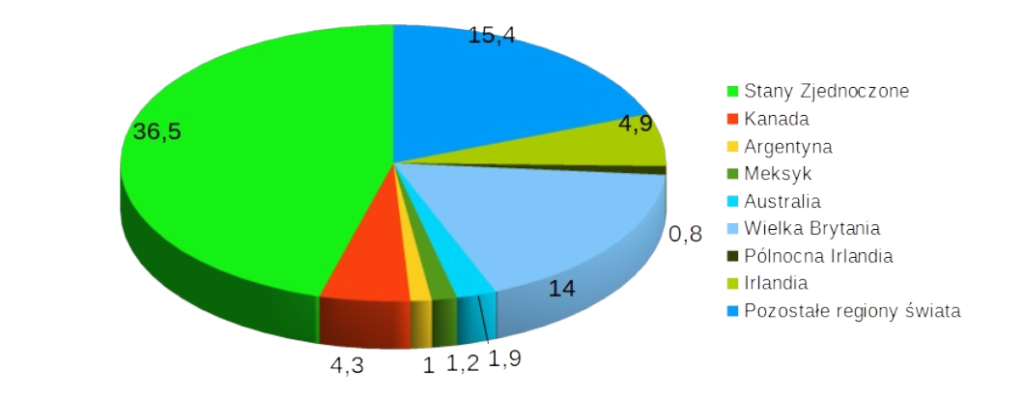
Decatholisation
For centuries, the Irish people, under pressure from the Anglicans, defended their Catholic faith and refused to renounce their attachment to the Roman Catholic Church. An important event in strengthening their Catholic identity, after the great famine and huge emigration, were the Marian apparitions in Knock in 1879. The apparitions of Our Lady gave a new impetus to the revival of the national and Catholic spirit in Ireland. The slow process began on the way to independence, which the Irish regained in 1921. For centuries, the Catholic faith set the direction of the nation’s life, and the Church was the unquestionable teacher of social and national life. Today, in 2022, this is no longer the case. The Church has lost its mission of being a teacher of social and national life. It was weakened by socialist circles of various colors (revolutionary, communist, leftist, liberal, gender and cultural anthropology), as well as by Masons of various lodges and extreme feminists who accused the Church of all the evil that could be done against the Irish people. But to better understand the plan of action to undermine the Church, we need to follow all of Ireland’s decatolization efforts over the past few decades. The first stage (1918-1979) weakening the spirituality and morality of the Irish was the propaganda of the idea of birth control and „conscious motherhood” after World War I. A slow but very effective process of weakening the family and ousting children from families had begun. The anti-natalist ideas reached the Irish from Great Britain24. It was slow but
a very effective action to weaken the faith in Irish families. The natural piety and godliness of the Irish were slowly dying out. Faith was becoming a cultural heritage that was still cherished among the Irish. This process took several decades. World War II seemed to revive faith in God among the Irish, but the process was too short. The spiritual and moral renewal of the nation has not been accomplished. At that time, the leftist circles were constantly promoting and distributing contraceptives, which very effectively destroyed the spirituality of the Irish people. In the 1970s, a large group of Irish people (around 30%) developed a contraceptive mentality. And since the birth of the contraceptive pill in 1979, contraception has been slowly but surely destroying marriages. Since 1992, the contraceptive pill has become available to everyone. The next stage of the sexual revolution in Ireland was the legalization of divorce in 1995. The marriage lost its stability and legal protection. Twenty-five years after the introduction of divorce, there has been a sharp decline in the number of marriages, and the number of divorces has increased significantly. Marriage and family are deconstructing very quickly in favor of free unions. Young people contest marriage in favor of civil unions without responsibility. Sacramental marriages that guarantee family stability are becoming a thing of the past.
Killing unborn children on behalf of the established law in 2018 became a marker of cultural change in Ireland. From a civilization of life where human life was defended from conception to natural death, the nation passed to the civilization of death where any child conceived in the womb can be killed. Ireland found itself in the circle of a demonic civilization. In 100 years, about 300,000 jobs were made on Irish soil. the murder of innocent, unborn children.
The next stage of decatolization covered children and adolescents. For several decades in Ireland, the upbringing of children has been undertaken by depravers in various areas of their influence, promoting, inter alia, gender ideas and accusing the Roman Catholic Church of sexual abuse against the youngest generation. Leftist circles carried out a perfectly prepared action to ridicule and accuse clergymen of sexual abuse. The media, state and administrative institutions, non-governmental organizations, the public and many clergy were involved in this practice25. Which made the Church deprived of the moral right to look after children and youth. One of the most important areas in which the depravation and demonization of the younger generation is taking place are nightclubs. Where the youth are subjected to a kind of demonic initiation. In addition to the ubiquitous alcohol and drugs, there is not only permission, but also encouraging sexual debauchery with the help of music and a specific atmosphere demonizing the young generation of Irish people. This process has been going on for several decades. Participating in a few hours of fun in a nightclub leads to the disco syndrome which „causes dullness of the mind and the lack of a realistic assessment of reality. This state of affairs lasts for several hours after participating in the game. „leading to spiritual enslavement and rejection of faith in God and aggression towards everything that is sacred ”26.
Decatholisation led to the disappearance of many pastoral forms that the Church had led for many centuries. The number of the faithful attending Sunday and holiday Masses decreased, and the seminaries, female and male monasteries were deserted. Many clergymen have left the ranks of the priesthood. The Church withdrew from preaching the Good News in favor of a light, non-irritating preaching. He lost his important role as teacher of the Irish people. The resignation from preaching the Good News led to the demoralization of children and youth on a mass scale, which ultimately leads the entire nation astray.
Projected population of Ireland without historical turbulence
So what would Ireland’s population be without the turbulence of history had the fertility of the early 20th century been preserved? Let us find an answer to this question. Based on the calculations carried out on the example of Poland, we have managed to determine that the world’s population in 2020, without historical turbulence, would be around 13.55 billion27. In 1900, the share of Irish people in the world population was 0.19%. Thus, if this share remained at a similar level for over 120 years, the population of Ireland in 2020 would be around 25 million, and there would be around 355 people per square kilometer, much less than today in Israel28 (377 people per km2 – 2018 r.) or in the Netherlands29 414 people per km2.
So what was the major depopulating factor?
In 2020, about 4.99 million people lived in Ireland30, and migrants in this group amounted to about 0.64 million. The native population of Ireland was 4.35 million people. Abortion reduced Ireland’s population by approximately 0.3 million. Human life does not run with mathematical accuracy, it causes various vicissitudes, therefore miscarriages and other random events reduced the Irish population by about 1 million children31. In total, all historical turbulences reduced the number of Irish residents by 1.3 million over 120 years, and together with the current inhabitants we get 6.29 million. Up to 25 million, we still need about 18.71 million human lives. This group of human beings did not see the light of day because of contraception, and most of all because of the pill launched in 1979. Death-civilization circles boast of contraceptives that eliminate unwanted pregnancies. For the communities promoting the civilization of life, it is one of the greatest failures in the history of mankind. It leads all mankind astray into non-existence.
The main factors of depopulation and people in Ireland in the years 1900-2020 (in millions)
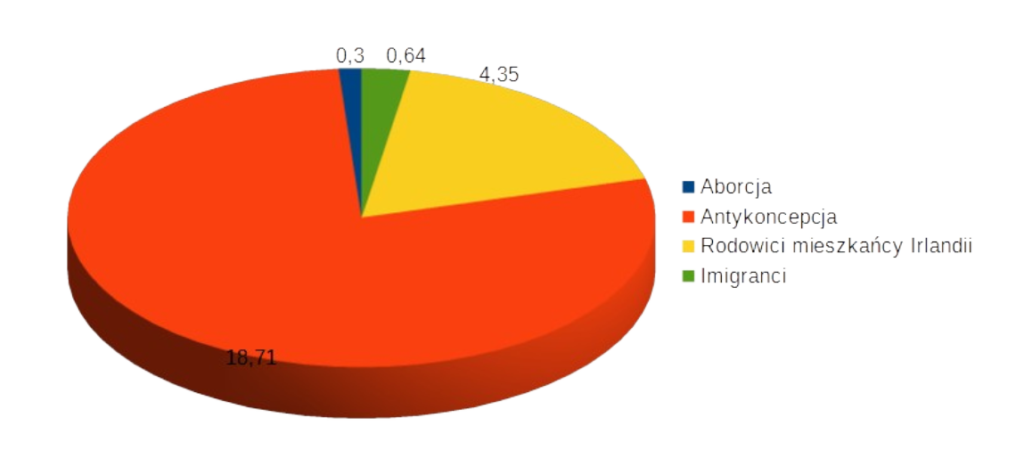
Summary
The greatest havoc in the Irish population was caused by contraception, in the nineteenth century the potato blight and emigration. For hundreds of years, the Irish were a people who followed the teachings of the Roman Catholic Church in their lives. Yet the ideas of the civilization of death were so powerful and suggestive that they made the greatest changes to the Irish people. The activity of the Roman Catholic Church was perfectly weakened by accusations of pedophilic acts. From the end of the 20th century, the Church lost its evangelizing power. Today, Ireland is one of the many European countries where the population is declining so fast. The main cause of Ireland’s depopulation is contraception, and most of all the pill: in recent years, also abortion.
Fr. Krzysztof Bielawny
Translation of Professor William A. Thomas
Consultation by Lidia Modrzakowska
Przypisy:
1 Population of the world, https://pl.wikipedia.org/wiki/Ludno%C5%9B%C4%87_%C5%9Bwiata, access: 20.02. 2022
2 Demografia Irlandii, https://en.wikipedia.org/wiki/Demographics_of_the_Republic_of_Ireland, dostęp: 11 .03. 2022 r.
3 K. Bielawny, Germany without Germans, “Nasz Dziennik” 2022, no. 12 of 17 I.
4 See K. Bielawny, Depopulation of France, https://demografia.com.pl/index.php/depopula-francji/, accessed 1 .04. 2022
5 See. Contraception in the Republic of Ireland,
https://en.wikipedia.org/wiki/Contraception_in_the_Republic_of_Ireland, accessed: 12.03. 2022
6 See. Demographics of Ireland, https://en.wikipedia.org/wiki/Demographics_of_the_Republic_of_Ireland, accessed: 12.03. 2022
7 See Father Bosomotwe, Once a ban on divorce, now free abortion. Will Poland follow Ireland ?, https://noizz.pl/spoleczenstwo/od-zakazu-aborcji-do-dostepnej-aborcji-czy-polska-zmieni-sie-jak-irlandia/93zg540, accessed: 12.03. 2022
8 See J. Lipski, P. Chybalski, Comparative information on the models of the constitutional guarantee of protection of human life in the perspective of permissibility of termination of pregnancy, Warsaw 2007, p. 91,
http://orka.sejm.gov.pl/WydBAS.nsf/0/EF539D2C23CBE8ADC125726F003C2FD0 /$file/993%20Konstytucji.pdf, accessed: 12.03. 2022
9 See M. Czarnecki, The undisputed victory of the supporters of lifting the abortion ban shows how Ireland is changing, https://wyborcza.pl/7,75399,23454623,bezapelacyjne-zwyciestwo-zwolennikow-zniesienia-zakazu-aborcji.html, accessed: 12 .03 . 2022; see N. Harbuz-Karczmarewicz, Savita failed to miscarry, she begged doctors to terminate the pregnancy. After her death, Ireland was in turmoil, https://www.wysokieobcasy.pl/wysokie-obcasy/7,163229,25935896,tysiace-milczacych-irlandek-symbolem-drogi-do-zoszenia.html, accessed: 12.03. 2022
10 See M. Nowicki, The Funeral of the Holy Ireland, https://www.newsweek.pl/swiat/referendum-aboracyjne-w-irkieta-demokracja- resa-sie-mocno/ee9k9h4, accessed: 14.03. 2022
11 See. Historical abortion statistics, Ireland, https://www.johnstonsarchive.net/policy/abortion/ab-ireland.html, dostęp: 13 .03. 2022 r.
12Zob. Referendum w Irlandii w 1986 r., https://pl.wikipedia.org/wiki/Referendum_w_Irlandii_w_1986_roku, dostęp: 16 .03. 2022 r.
13Zob. E. Marzec, Rozwody w Irlandii legalne są dopiero od 24 lat!, https://wirlandii.pl/2019/05/rozwody-w-irlandii-legalne-sa-dopiero-od-24-lat/, dostęp: 13 .03. 2022 r.
14Ibidem.
15Zob. W. Kochowski, O rozwodach, Przemyśl 1907, s. 136-137.
16Zob. Małżeństwa 2020 w Irlandii, https://www.cso.ie/en/releasesandpublications/ep/p-mar/marriages2020/marriages2020mainresults/, dostęp: 14 .03. 2022 r.
17L. Farsaci, Pary irlandzkie w separacji mogą uzyskać legalny rozwód w ciągu dwóch lat zamiast czterech, https://www.irishmirror.ie/news/irish-news/legal-divorce-time-ireland-separation-13577677, dostęp: 14 .03. 2022 r.
18 Zob. A. Winkler, Brytyjczycy rozmyślnie zagłodzili milion ludzi?, https://wielkahistoria.pl/wielki-glod-w-irlandii-czy-brytyjczycy-rozmyslnie-zaglodzili-milion-ludzi/, dostęp: 16 .03. 2022 r.
19Zob. Wielki głód w Irlandii (1845-1849), https://pl.wikipedia.org/wiki/Wielki_g%C5%82%C3%B3d_w_Irlandii_(1845%E2%80%931849), dostęp: 16 .03. 2022 r.
20Zob. Irlandczycy, https://pl.wikipedia.org/wiki/Irlandczycy, dostęp: 14 .03. 2022 r.
21Zob. Diaspora irlandzka, https://en.wikipedia.org/wiki/Irish_diaspora, dostęp: 17 .03. 2022 r.
22 Zob. K. Bielawny, Dramat depopulacji, „Nasz Dziennik” 2021, nr 188, z 16 VIII.
23 Zob. B. Niedziński, Po raz pierwszy od 1851 r. liczba ludności Irlandii przekroczyła 5 mln, https://www.bankier.pl/wiadomosc/Po-raz-pierwszy-od-1851-r-liczba-ludnosci-Irlandii-przekroczyla-5-mln-8179917.html, dostęp; 15 .03. 2022 r.
24Zob. K. Bielawny, Depopulacja wielkiej Brytanii, https://demografia.com.pl/index.php/depopulacja-wielkiej-brytanii-great-britain-depopulation/, dostęp: 17 .03. 2022 r.
25Zob. Ferns Report, https://en.wikipedia.org/wiki/Ferns_Report, dostęp: 24 .03. 2022 r.; zob. Commission to Inquire into Child Abuse, https://en.wikipedia.org/wiki/Commission_to_Inquire_into_Child_Abuse, dostęp: 24 .03. 2022 r.; zob. „Wyborcza” zachwycona. Bo Hiszpania i Irlandia odchodzą od Kościoła. I z nadzieją pyta: Kiedy u nas?, https://dorzeczy.pl/kraj/76142/wyborcza-zachwycona-bo-hiszpania-i-irlandia-odchodza-od.html, dostęp: 24 .03. 2022 r.
26Zob. K. Bielawny, Syndrom dyskotekowy, https://demografia.com.pl/index.php/2022/01/30/syndrom-dyskotekowy/, dostęp: 16 .03. 2022 r.
27Zob. K. Bielawny, Dramat depopulacji, „Nasz Dziennik” 2021, nr 188, z 16 VIII.
28 Zob. Izrael, https://pl.wikipedia.org/wiki/Izrael, dostęp: 18 .03. 2022 r.
29Zob. Holandia, https://pl.wikipedia.org/wiki/Holandia, dostęp: 16 .03. 2022 r.
30Zob. Demografia Irlandii, https://en.wikipedia.org/wiki/Demographics_of_the_Republic_of_Ireland, dostęp: 11 .03. 2022 r.
31Obliczenia własne na podstawie: Historical abortion statistics, France, http://www.johnstonsarchive.net/policy/abortion/ab-france.html, dostęp: 23 .02. 2022 r.

